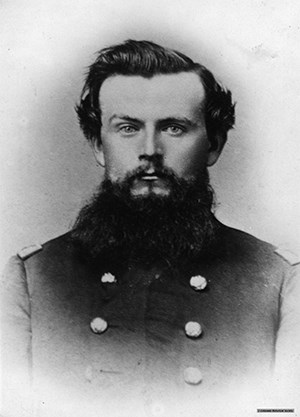Commanding OfficersConflict on the PlainsThe situation around Fort Larned was not particularly good at the beginning of 1864. According to Homer H. Kidder, civilian quartermaster clerk, that winter was “intensely cold” while tensions continued to run high between the Indians and the white traders flowing down the Santa Fe Trail in ever larger numbers. The fragile peace worked out by Col. Leavenworth was threatened by the acts of both Indians, who continued to raid wagons and steal goods, and whites, who chased buffalo and harassed Indians when they could. |

Public Domain The year started with Captain H.N.J. Reed, Ninth Kansas Volunteer Cavalry, in command, having assumed the position in November of 1863. Lieutenant Watson D. Crocker, Ninth Wisconsin Battery, replaced him in March. At the time there were only 92 enlisted men to carry out all the duties at the post, both the chores associated with garrison duty, as well as patrols in both directions along the Santa Fe Trail. Captain James W. Parmetar, Twelfth Kansas Volunteer Infantry, assumed command of the post in April, just as hostilities between Indians and Whites along the Santa Fe Trail escalated. Trouble with Indians in the surrounding area resulted in several skirmishes between them and the troops stationed along the trail. By July of 1864 the fort’s garrison had been reinforced by the arrival of the Fifteenth Kansas Cavalry, adding 325 enlisted men to the troop totals at Larned. This was also the month when one of the more famous events in the fort’s history took place: a raid by a band of Kiowas resulting in the loss of a large number of horses and mules. According to a report by the post surgeon at the time, the Kiowas surrounded the fort intending to attack and kill the soldiers. When that proved impractical, they drove the horses and mules off instead. In response to this incident, the commander of the Colorado Military District, Col. J.M. Chivington, came to Fort Larned that same month bringing a company of soldiers for reinforcements. He relieved Capt. Parmetar of command, who would later be dismissed from Army service for “habitual drunkenness” and replaced him with Capt. William H. Backus. Maj. Gen. Samuel Curtis, commanding the Department of Kansas, arrived at Fort Larned on July 28th, bringing four companies of the First Colorado Cavalry with him. Gen. Curtis’s stay was brief. He left on the 31st, after creating the Military District of the Upper Arkansas and placing Maj. Gen. James G. Blunt in command. Another consequence of the Kiowa raid was the construction of the first of Fort Larned’s stone structures. That incident along with similar ones at other forts in the area resulted in General Field Order No. Two from the Department of Kansas headquarters, making better fortifications mandatory to protect government livestock. The order also specifically reprimanded Fort Larned’s commander for not providing a stone blockhouse or animal enclosure. By February of 1865, Col. James H. Ford reported that a stone fortification was under construction at the fort. As the long, hot summer of 1864 wore on, blood continued to spill along the Santa Fe Trail as Indians resisted trail traffic through their lands and hunting grounds, and traders were equally determined to continue their traffic along the trail. By August, Maj. Scott J. Anthony, First Colorado Cavalry, took command of Fort Larned from Capt. Backus. Garrison forces at that time were recorded as 359 officers and men from the First Colorado and Fifteenth Kansas Cavalry regiments, along with the Twelfth Kansas Infantry and Ninth Wisconsin Battery. In August, Colorado governor, John Evans, got permission from the War Department to recruit 100-day volunteer troops in an effort to provide settlers with protection from Indians. With that permission, Governor Evans issued a proclamation essentially calling for an all-out war against Indians in Colorado, authorizing any citizen of the state “to go in pursuit of all hostile Indians on the plains…” Although the proclamation also called for these citizens to avoid friendly Indians who would be gathering in pre-arranged locations, the result was to give free reign to anyone in the area who wanted to attack Indians. It would also lead eventually to the Sand Creek Massacre. In October, Maj. Anthony received word that he would replace Maj. Wynkoop as commander of Fort Lyon. He left Fort Larned on October 28th turning over command of the post to Capt. A.E. Jacobs of the First Colorado Cavalry. Capt. Jacobs would be replaced the following month by First Lt. W. D. Crocker of the Ninth Wisconsin Battery, who would finish out 1864 as the fort’s 7thcommander. So ended another difficult year for Fort Larned. Frequent command changes along with continued trouble between the Indians and White traders and settlers were part of the challenges faced by the small post in the heart of Kansas. Lack of unified military and political direction from the Federal government meant that policy, and actions, were determined by the desires, and fears, of local citizens and politicians. |
Last updated: February 13, 2024
